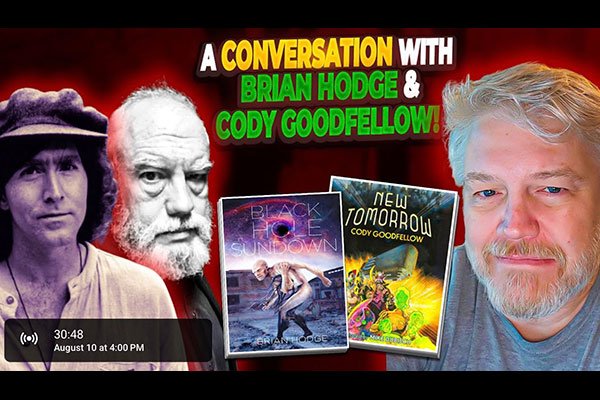The Loss That Never Gets Any Easier to Bear
1
I love critters. This has been a lifelong constant. Although most of my formative growing-up years were spent with a border collie, plus occasional visits with my grandfather’s bird dog, I never took a side in the great dog-cat schism. Dog people vs. cat people? It’s a false dichotomy to me. Critters is critters. If we had the room, you can bet there would be a few goats roaming around, too.
Still, ever since moving to Colorado twenty-five years ago — a wonderland of a state if you’re of the canine persuasion — it’s only been cats for us. That’s how it’s worked out so far. But not just any cats. Big, long-haired, goofy, dog-like cats that bring the best of both kingdoms: Maine Coons, plus a rescue adoptee who came billed as a Maine Coon, then grew up into a Nebelung.
We’ve named them after gods and outlaws and mythological beings, and they’ve lived up to these exalted monikers.
Despite humorist Dave Barry’s years of references to working around his household’s main dog and emergency back-up dog, cats have usually seemed the more fitting companion for the offices of writers, for libraries and bookstores, for studios of all kinds. Maybe because, since they’ll nap at whatever altitude they can reach, they more completely become a part of the furnishings. Plus they never demand walks at inconvenient creative times and they fart less.
But it’s your space. Dogs, cats, ferrets, iguanas, tarantulas, freshwater puffers — populate it as thou seest fit. You know in your heart who belongs.
Studio cats. Above, Green Man Studio’s very own floofiest gear junkie. Below, assistants for two of my favorite musicians on YouTube: Martin Stürtzer with Neptune (Germany); Perry Frank with Lisetta (Sardinia).
2
Starting with a big, handsome lad named Fionn — outlaws, remember — it has amused me to give them job titles. In practice, this is little different from no-show construction jobs for mobsters: Someone else clocks them in and does the work, and they get paid anyway.
Their real job, of course, is their presence — technically animal but, if you’ve lived with one long enough, an aura that comes to feel more numinous than that, with a magnitude entirely out of proportion with their size. One of my favorite observations on this was someone’s remark about their love of having those extra heartbeats around the house.
Until we lost Fionn twelve years ago, I hadn’t consciously realized that, by virtue of what I do and where I do it, I’d spent more time around him than any other living being, even Doli, the woman I love.
Their real job, then, at its most fundamental level: expanding love’s web of sources and destinations. Their hearts make better realms of our own.
And then one day they leave, and your heart feels like it’s taken a hit from a sledgehammer, and it’s a struggle to simply draw in a deep, satisfying breath.
3
We’ve just been through it again, at the beginning of last month. Selkie, her name was — mythological beings, remember — and we brought her home as a kitten of twelve weeks old, as shaggy as a musk ox and with big ears sprouting lynx tips from Hell.
Newly arrived and dwarfed by a 20” monitor.
As she grew, charm became her superpower. She was so friendly, so trusting, so clever, so goodnatured, that anyone who met her came away enchanted. Even Loki, the Maine-Coon-turned-Nebelung, sixteen months older and at the time much bigger, fell under her spell. She was talkative, with a wide vocabulary of inflections and mimicry, and just the right degree of bossy. She listened, too. Reaching up a huge, furry paw to touch us near our mouths seemed to be her cue that she wanted someone to talk to her.
Some higher essence always seemed to be going on behind her eyes. From the beginning, she had this way of looking at us, watching us — especially Doli — as if studying things she really wanted to learn. If you were to have told me you had it on unimpeachable authority that certain animal souls were in training to become human souls, I would’ve replied, “Hmm, I think we might have one of them here.”
Fully grown, owning the place, and casually blocking a 27” iMac Pro.
After ten years of vibrancy and glowing reports from her vet check-ups, with every reason to believe she would enjoy several more, her health started to wobble late last year. We could never get things managed for long. Any apparent progress soon slipped away.
Yet still she was so friendly. Still so trusting and clever and up for mischief.
In early July, a medical emergency put her in the veterinary hospital for a few days. While learning the extent of her underlying issues was disheartening, now we at least knew what they were, and came out of it thinking we might finally be getting a handle on matters.
Those next three weeks remained good days, with room and reason for hope. And still she was so goodnatured. Still watchful and bossy and prone to stealing my office chair. She still bunked with us on what turned out to be her final night.
The next morning was different, from the time we got up. Sometimes, when they fade, they fade fast.
4
Doli and I had talked it over days earlier, agreeing that if Selkie took another serious downturn, we didn’t want to see her back in a hospital cage with tubes coming out of her again, forestalling what had come to seem inevitable.
One last trip to the vet, then, still daring to hope, but we’d been here twelve years ago and knew the miserable territory better this time: that point where hope and interventions and love and devotion to an everyday regimen of care are no longer going to be enough.
Recognizing this, admitting it, dealing with it … that’s your job now.
“Anywhere but here.” The vet techs’ sign, before getting smudged: CAGE BOLTER (but sweetest baby).
Ultimately it came down to buying some extra time and keeping her comfortable while I scrambled around making phone calls, until I found someone from the vet’s recommended-list who could do an in-home euthanasia on such short notice. We were adament about not wanting this handled in an office. We wanted to make our goodbyes from home.
We brought her back in mid-afternoon, and continued to keep her comfortable. We talked to her. A lot. We stole back a little over two hours with her before the appointment.
Afterward, I took the earlier wraps and injection port and glucose sensor off her. We groomed her, combing and brushing everywhere we would’ve gotten on any other day, then positioned her in a gentle curl. And from that point on, until the very end of the road, it looked as if she were only sleeping.
5
My ethos is that you stay with them through the end, and beyond. You take them every step of the journey, as far as you possibly can.
Maybe they’ve been there for you, too, when they could, in their own way.
Remembrance: Seven years earlier, after I’d shredded my left knee and needed the patellar tendon pieced back together, how Selkie would lie close alongside my swollen, stitched-up leg.
Remembrance: Last November, after Doli had surgery on her ear canal, how Selkie peered at her as if taking the measure of things, then climbed up to join her in a plush chair, pressing and folding and squeezing in tight, radiating … well, it sure sounded like love to me.
Where else could it come from, this recognition of need, this total application of presence, this wordless utterance that couldn’t be any more clear even if it were spoken aloud:
I don’t know what’s happened to you, but I’m here to make it better.
6
The next morning, the day before what would’ve been her eleventh birthday, we set out to drive her to the crematorium an hour north. As soon as we pulled out onto the street, a mourning dove swooped startlingly low across our path, closer than birds usually get to a car.
We carried her ourselves into the facility’s work area. Rested her on their scale. Slipped her into the vinyl bag for temporary safe-keeping. And, at last, set her on the rolling table to wait until they could take it from there.
Every step of the way, as far as you possibly can.
To me, there’s a cleansing in this, a sense of honoring and completion that wouldn’t be there were we to leave these last miles and final tasks to someone else.
7
There is no neat wrap-up here.
To recount is to relive. Weeks later, the heart hurts anew, and drawing in a deep, satisfying breath has again become a struggle. Our space has a hole in it, with a specific shape; a silence where there used to be some of my most favorite lifesounds ever.
It’s a double-edged sword, this bond between our kind and theirs, with lives that unfold along such different timescales. Unless you’re sharing your home with a Galapagos tortoise or a Greenland shark, you have willingly signed up for the likelihood of this pain. It doesn’t come close to negating the years of joy and all those uncountable moments of perfect, uncomplicated togetherness. But it’s the depth and duration of the joy that makes the loss so much harder to bear.
Years ago, in a piece called “The Firebrand Symphony,” I wrote this line:
Everything we most enjoy doing is done a finite number of times, and, whether or not we realize it in the moment, one of them will be the last.
I know what I’d be doing now, one more time, if I could.
So maybe that’s the wrap-up, because I need the reminder as much as anyone — never forgetting this truth, and striving to live accordingly.
While wishing for one more day, one more day, one more perfectly ordinary day.









Somewhere early in that span, all sense of myself as a writer — this thing that had been a core identifier almost my entire life — slipped away.